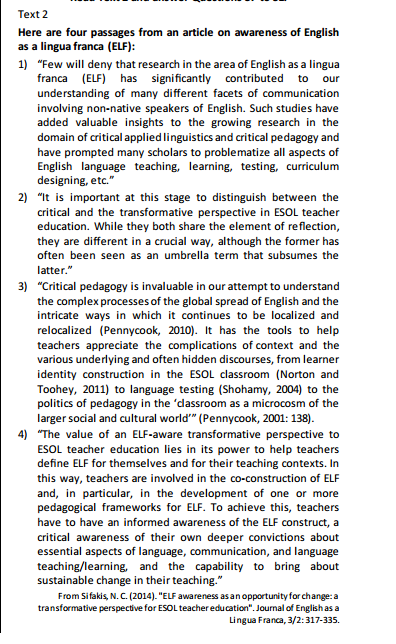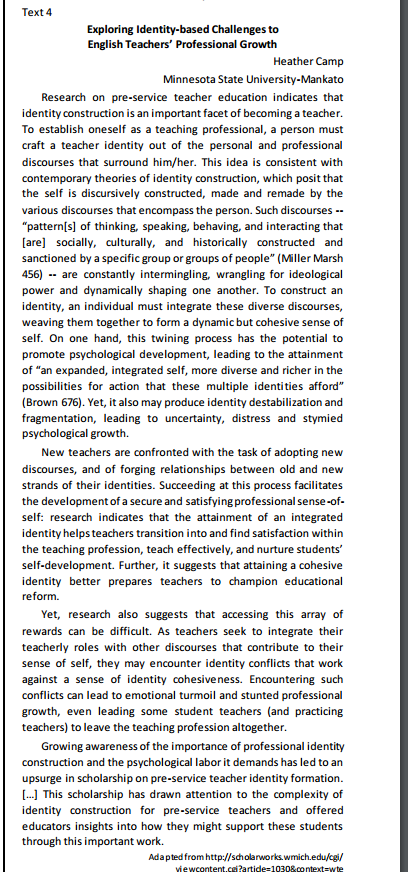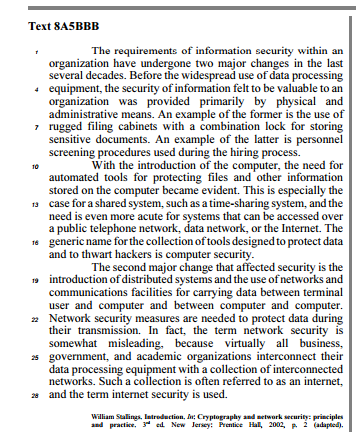Passage 4 suggests that a transformative perspective to ESOL teacher education requires that teachers become more
Critical literacy supporters tend to see the discourse of “the now ‘classic’ critical pedagogies of the 80s and 90s” (Jordão, 2013, p. 290) as being
It is currently assumed that the teaching/learning of English as a
Foreign Language in Brazilian public schools has not been
successful (Jordão, 2013, p. 286-287).
Read the statements below and mark them as TRUE (T ) or
FALSE (F ).
( ) Teachers’ lack of qualification may contribute to this
perception.
( ) This is because local cultures and discursive practices are
disregarded.
( ) To solve this problem, basic rules of grammar and vocabulary
should be taught.
The statements are, respectively:
From the point of view of more recent pedagogies, the teacher’s statement is rather
In the context of Text 4, the fragment “Yet, research also suggests that accessing this array of rewards can be difficult.” introduces (an)

Judge the following items according to the text CB3A1AAA.
Even some applications once seen as sequential are now demanding concurrent computation.

In the text CB3A1AAA,
“state-of-the-art technologies” (l25) are advanced technologies, developed with an artistic touch.
Judge the following items according to text 5A5AAA.
Mesh topologies differ from others because the failure of the
central element results in the failure of the whole network.
Judge the following items according to text 5A5AAA.
If any network element fails in whatever kind of network,
operations will be interrupted.
People with disabilities can use websites and web tools
when they are properly designed. However, currently many sites
and tools are developed with accessibility barriers that make it
difficult or impossible for some people to use them.
The absence of an alternative text is the classic example.
Sites and tools with images should include equivalent alternative
text in the markup/code.
If an alternative text is not provided for images, the image
information is inaccessible, for example, to people who cannot see
and have to use a screen reader that reads aloud the information on
a page, including the alternative text for the visual image.
When an equivalent alternative text is presented, in HTML
format, for example, information is available to everyone to people
who are blind, as well as to people who turned off images on their
mobile phone to lower bandwidth charges, people in a rural area
with low bandwidth who turned off images to speed download, and
others. It is also available to technologies that cannot see the image,
such as search engines.
Another example of barrier is the lack of keyboard input.
Some people cannot use a mouse, including many elderly users with
limited fine motor control. An accessible website does not rely on
the mouse; it provides all functionality via a keyboard.
Just as images are not available to people who cannot see,
audio files are not available to people who cannot hear. Providing
a text transcript makes the audio information accessible to people
who are deaf or hard of hearing.
It is easy and relatively inexpensive for website developers
to provide transcripts for podcasts and audio files. There are also
transcription services that create text transcripts in HTML format.
Most of the basics of accessibility are even easier and less
expensive than providing transcripts. However, the proper
techniques are poorly integrated into some web tools, education,
and development processes.
Internet:
Judge the following items according to the text above.
HTML format is a kind of search engine.
Read the following extract from Text 1: “Multiliteracies
recognizes both the increasing cultural and linguistic diversity in
the new globalized society and the new variety of text forms from
multiple communicative technologies.” (L.11-14)
The alternative from Lotherington (2006) that has some analogy
to this passage is:
As regards Passage 2, analyse the assertions below:
I. A critical orientation may include a transformative view.
II. Critical and transformative perspectives in ESOL are
indistinguishable.
III. Transformative perspectives are wider than critical
orientations.
Choose the correct answer:
Consider the following statement: “the teaching of a foreign
language […] tends to place ‘non-natives’ locally involved in the
process of teaching/learning in a subordinate position when
confronted with the authority attributed to the ‘natives’ in what
is considered ‘their own language’” (our translation) (Jordão,
2013, p. 280).
Here, the writer is attributing this view to
New critical literacy assessment is discussed by Duboc (2016). The only statement that does not reflect this view of assessment is:







